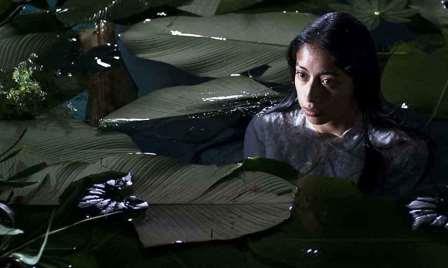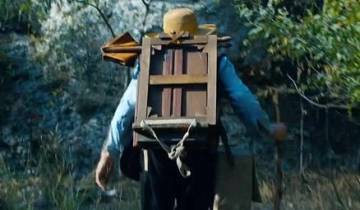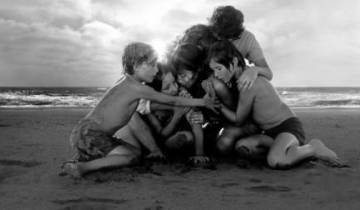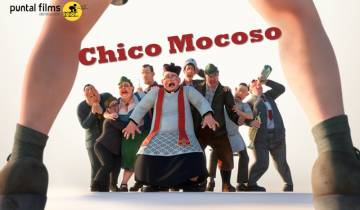
The Llorona
Direction: Jayro Bustamante Screenplay: Jayro Bustamante and Lisandro Sánchez
Performers: María Mercedes Coroy as Alma, Sabrina de la Hoz (Natalia), Juan Pablo Olyslager (Letona), María Telón (Valeriana), Julio Díaz (Enrique Monteverde)
Country and Year: Guatemala / France, 2019
Duration: 1h 37 min

By Adriana Schmorak Leijnse
La Llorona is a 2019 Guatemalan film directed by Jayro Bustamante. Its script was written by Bustamante and Lisandro Sánchez, who were inspired by the legend of La Llorona and the history of Guatemala, specifically in the genocide perpetrated between 1982 and 1983, against the Ixil ethnic group, a branch of the Mayan people who live in the northern Guatemala.
The film was premiered on August 30, 2019 at the Venice Film Festival, within the Giornate degli Autori ("authors' day"), the section where Bustamante received the award for best director. La Llorona was selected by Guatemala as a candidate for the Oscars in the category of best international film. Although it was among the fifteen feature films shortlisted for that category, it was not one of the five finalists.
However, it was nominated for other awards, including the Best Foreign Language Film at the Golden Globes and Best Ibero-American Film at the Goya Awards.
La Llorona is part of a thematic trilogy by director Jayro Bustamante, which revolves around acts of discrimination that occur in Guatemala, such as homophobia, classism and racism. The so-called "trilogy of contempt" or "trilogy of the three insults" is also composed of the films Ixcanul (2015) and Tremors (2019).
The film begins with the trial of a fictional military man, General Enrique Monteverde, accused of crimes against humanity due to a genocide for which he had been responsible decades ago in a rural area of Guatemala. Although he is initially convicted, the procedure is declared void and the sentence is void. Back home with his family: Carmen, his wife; Natalia, his daughter and Sara, his granddaughter, and in the midst of protests from those who are dissatisfied with the outcome of the trial, the man begins to listen to the cry of a woman at night and to experience some supernatural events. Her erratic behavior scares the house employees, who decide to resign, prompting the arrival of a mysterious young woman named Alma to work as a servant.
Historic context:
The character of General Monteverde is directly taken from the Guatemalan military and former de facto president Efraín Ríos Montt, who was put on trial in May 2013 for crimes against humanity, committed during his government between 1982 and 1983. It was not only about deaths , but also torture, rape and exile against the Ixil ethnic group.
Despite the seriousness of the charges against him, some time after the trial, his sentence was overturned. Ríos Montt died in 2018, without having received any punishment. Rigoberta Menchú, indigenous activist and winner of the Nobel Peace Prize in 1992, participated in the real process as a witness and in fiction as one of the extras that appear in court.
The genocide that took place during the government of Efraín Ríos Montt is part of a larger context, that of the civil war in Guatemala that lasted 36 years (from 1960 to 1996) between the official army and the leftist guerrillas.
In those more than three decades of conflict, there were 669 massacres, 200 dead and 45 missing. Of the victims, 98% were indigenous descendants of the Mayan people, and the rest, university students, socialist and communist activists and peasants of different origins. Thousands of indigenous people living in northern Guatemala were forced to cross the border and take refuge in the Chiapas region, southern Mexico.
Mythological sources:
The legend of La Llorona has pre-Hispanic origins, in the form of various characters with similar characteristics, present in the cosmogony and ancestral beliefs of the autochthonous peoples of America. During the Colonial era, the generalities of the legend took shape, and through time, the legend of La Llorona has become part of the collective imagination of Latin America, transcending borders and becoming part of cultural identity, folklore and popular imagery. from many countries. Today, the legend continues to be very popular from Mexico to Argentina and Chile, as well as in the southern states of the United States with the largest Spanish-speaking populations, such as Arizona, Texas and New Mexico.
La Llorona is a specter that, according to oral tradition, is the banshee of a woman who drowned her children, and then, repentant and cursed, searches for them at night in rivers, towns and cities, scaring them with her overwhelming crying to those who see or hear her at night. His legend has a great diversity of versions, with generalities and particularities typical of each region. Despite this, his magical and supernatural story is constant and recognizable, with additions, textures and hybrids from very different sources. Of all these characteristics, what has remained in common to this day is their white clothing, long black hair, the heart-rending cry of Ay my children! and its relationship with water.
One of the best known pre-Hispanic antecedents of the legend of La Llorona is that which identifies it with the Mexica goddess Cihuacóatl (the mother goddess and serpent woman). This goddess has different attributes: goddess of the earth (Coatlicue), of fertility and of childbirth (Quilaztli), warrior woman (Yaocíhuatl) and guardian of the dead (Teoyaominqui). In addition, she was the mother of Huitzilopochtli, the greatest of the Mexica gods.
Cihuacóatl was also the patroness of the spirits of women who died in childbirth. These spirits of dead women could be heard at night, crying out loud for the death of their children and for the loss of their own lives. They called her Chocacíhuatl - from Nahuatl choka, 'to cry', and cihuatl, 'woman'. If any mortal accidentally ran into these female spirits, it was a sure harbinger of misfortune or even death for him.
According to the dual conception of the Mesoamerican deities, Cihuacóatl was both the goddess of life and death, capable of creating and destroying her children. She was both a nurturing and a destructive mother. She was represented in the form of a woman dressed in a flowing white dress, flowing black hair, and materialized floating on the waters of Lake Texcoco while crying and screaming, lamenting the unfortunate fate of her children.
For their part, the indigenous peoples of Colombia and Venezuela have many versions of female divinities associated with water and nature. They are protective deities of forests, animals and water sources. Many of these female goddesses were avenging spirits who assaulted and punished lustful and unfaithful men.
In Costa Rica, La Llorona is a very beautiful indigenous woman, the daughter of an Huetar king, who fell in love with a Spanish conqueror, with whom she was alone at the top of a waterfall, becomes pregnant and gives birth to a son. who is killed by the woman's father, throwing him from the top of the waterfall. Cursed by the father, she wanders eternally along the banks of the rivers looking for her lost son, persecuted by evil spirits and mourning her misfortune.
The legend of La Llorona that we know today takes shape during the Colony, because to the pre-Hispanic antecedents, the Spanish contribution to establish the myth as such is added, making La Llorona one of the first signs of miscegenation.
In the folklore of Spain she is known as the Lady in White. It is the ghost of a snowy-looking woman who wanders along water courses, such as rivers, fountains or wells, and could be both dangerous or beneficial to those who come across them. According to legend, the lady in white was a woman who had killed her children for unrequited love.
On other continents, outside of America and Europe, there are similar myths. In Africa, between the Yoruba peoples of Dahomey and Togo, a legend is narrated that describes the wind as a woman who travels the rivers making fearful laments and looking for her murdered children. These were drowned by the ocean (which in this myth is also a woman) and their remains scattered throughout the world. This legend, which bears strong similarities to that of La Llorona, was introduced to the United States by African slaves brought by Europeans to America and is especially well known in southern states such as Louisiana.
Chinese folklore is rich in ghost stories and legends, and one of these stories tells of the appearance of a woman dressed in white crying and lamenting through the corridors of Beijing's Forbidden City.
In Japan, the ghosts that return to the world to take revenge are called onryo. These are generally women dressed in a white kimono, with long black hair and pale complexions.
Literary Background:
The literary trend that probably most influenced Jayro Bustamante's film is Magic Realism. This movement arose between the 1940s and 1960s as a fusion between European Surrealism -whose main themes are: the dream, the unconscious, instincts, love, death and cruelty- and the magical thinking of the indigenous Afro-American peoples who live in Hispanic America. Its characteristic is an irrational way of perceiving the world, since it shows us that the wonderful is present in everyday life.
One of the most illustrious precursors of Magic Realism was the Nobel Prize for Literature, the Guatemalan writer Miguel Ángel Asturias. Among his best-known works are “Leyendas de Guatemala” (1930), a collection of nine stories that explore Mayan myths from pre-colonial times, as well as themes that refer to the development of a Guatemalan national identity. Their stories are important precursors to magical realism.
"El Señor Presidente", a novel he completed in 1933 but remained unpublished until 1946, when it came out in Mexico as a private publication. "El Señor Presidente" is a complaint against the Guatemalan dictator Manuel Estrada Cabrera.
The novel was written during the exile of Asturias, in Paris. In that period, Asturias was associated with members of the surrealist movement, as well as with other future Latin American writers, such as the Venezuelan Arturo Uslar Pietri ("Las Lanzas Coloradas", 1931) and the Cuban Alejo Carpentier ("The kingdom of this world, 1949).
"El Señor Presidente" is one of many novels that explore life under a Latin American dictator and, in fact, has been proclaimed by some as the first real novel to explore the theme of dictatorship. Many themes, such as justice and love, are mocked in the novel, and escaping the dictator's tyranny is seemingly impossible. Each character in the novel is deeply affected by the dictatorship and must fight to survive in a terrifying reality.
"Men of Corn" (1949) is generally considered Asturias's masterpiece, although it remains one of his least understood novels. The title "Men of Corn" refers to the indigenous Mayan belief that their meat was made from corn. The novel is written in six parts, each one exploring the contrast between the traditional customs of the indigenous people and a society in the process of modernization. The book explores the magical world of indigenous communities, a subject of which the author was both passionate and knowledgeable.
Written in the form of a myth, the novel is experimental, ambitious, and difficult to understand. For example, your time scheme is a mythical time in which thousands of years can be compressed and viewed as a single moment; furthermore, the language of the book is structured analogously to indigenous languages. Due to its unusual approach, it took some time before the novel was accepted by critics and the public.
Other fundamental authors of Magic Realism or "the marvelous real", as Alejo Carpentier called it, are: the Colombian Gabriel García Márquez - "One Hundred Years of Solitude" (1967), the Argentine Julio Cortázar - "Bestiary" (1951), "Final of the Game ”(1956),“ The secret weapons ”(1959) and the Mexican Juan Rulfo -“ El llano en llamas ”(1953) and“ Pedro Páramo ”(1955), among many others.
Film analysis
In the words of journalist Naief Yehya, “contemporary horror cinema is the genre that records historical traumas most starkly, be it the wars in the Middle East, terrorism, the tragedy of immigration, the destruction of ecosystems or global warming. global"
It is true, "La Llorona" belongs to the horror genre, but in its deepest sense, it is political cinema. It is political cinema because it looks at the past head-on and without fear, because it gives women a place that they do not have in most modern societies, because it closes in fiction a painful issue that remains unsolved in real life. For this and for much more, it is a film that transcends any gender classification. The legend and the recent history of Guatemala intersect until they are confused, but in the end the myth wins the battle. Those killed by the Guatemalan dictatorship of General Monteverde (Efraín Ríos Montt, in real life) return from beyond to demand justice. At first the images are fully realistic. But as the minutes of the narration pass, the fantastic gains a greater space, until the crowd that cries at the doors of the Monteverde house ceases to be made up of people of flesh and blood to become ghosts from the most there.
A series of strange events, involving Enrique Monteverde, produce terror in the servants of the family house. Therefore, they present their irrevocable demission, leaving the family with Valeriana, the oldest domestic in the house. From there, the story takes a definitive turn. It is the moment when Carmen decides to hire a new maid and Alma enters the scene.
The newly arrived domestic young woman who, according to Natalia, wanders through the house at night remembering her dead children, is a character who lives in a contiguous space between the real and the metaphysical plane, between waking and dreaming, between the dimension of the living and the world of the dead. Only that in the film his children are, metaphorically speaking, the Guatemalan people of Mayan descent. The legion of spirits who seek justice represents that people, the people of yesteryear and of the present, crying out at the doors of the repressor.
The director chose a version of the myth in which La Llorona's children have not been murdered by their mother but by a dictatorship in its effort to completely exterminate an indigenous ethnic group. Here, then, the murderer is another. In addition, it is clear that Enrique Monteverde is attracted to Alma. As he sleepwalks through the house, he follows her up the stairs to the basement. When listening to Carmen's laments about her husband's infidelities, we understand that many of these occurred with indigenous women, with all the sexist, racist and class that this implies.
The myth occupies an increasingly important space in history, like the element of water that floods and overflows the huge house, uncontrollable. Water constitutes the feminine and maternal element par excellence; the source of purification. Crying is also water and brings fertility to the earth.
The source of water represents the birth, a mighty river is the incessant flow of time and life. While the wide sea represents death, the place where the waters of the rivers will flow. Water has a very important mythological value among the American aborigines.
La Llorona appears incarnated in Alma, a wandering soul crying for her dead children. She can even hold her breath under the liquid element as if it were her natural environment. As if she wasn't human or came from the world of the living. Alma's white dress and long black hair perfectly match the way the native peoples have described La Llorona.
At the beginning of the film, the inhabitants of the house pray Christian prayers, but in the face of the extreme situation that the family lives, the women of the house, without distinction of age, ethnicity or social status, hold hands and practice a ritual of invocation to the old spirits that adds to the five in a species of transe.
Then a terrifying sequence unfolds in which Carmen is seen in a dream running into the mythical Lake Atitlán and crying out for her children while she watches the Guatemalan army drowning the children of the Ixil ethnic group. She is also running away from the soldiers so as not to be outraged and killed. The history of the conquest repeats itself, over and over again. From the ethnocide of the colony to the genocide at the hands of a military dictatorship in the middle of the XNUMXth century, the martyrdom of the Mayan people seems to have no end.
La Llorona's righteous spirit is embodied, this time, in Carmen. Once she does justice by her own hand, the natural forces calm down and everything in the house returns to normal. In this sense, it is important to highlight that the woman occupies a fundamental role in the film, and at times it gives the impression that the three generations of women: Carmen, Natalia and Sara, in addition to Valeriana (probably the extramarital daughter of Monteverde) and Alma, the youngest domestic; they constitute one and the same, that is, femininity in its generic sense.
The dreamlike and at the same time terrifying atmosphere of the film is very successful. But it is not Hollywood-style horror cinema. It is Magic Realism translated into cinematographic language. In the literary texts belonging to this Latin American literary trend, the realistic details are confused with fantastic and surreal situations, a duality of which the readers are aware but the characters are not. The same thing happens in the cinema. The characters experience surreal situations and environments as if they were part of their daily lives. In fact, they cannot distinguish a flesh and blood character from a spectrum, such as Alma, or a real space from an imaginary one, such as the transe sequence described above.
The three generations of women and the two domestic workers of indigenous origin end up doing justice and normalizing the situation. To do this, they join forces and make each element on the scene make sense. The genocide is finally sentenced, albeit in fiction, while the forces of nature calm down and the old house looks like it was in its best times.
BIBLIOGRAPHY:
Yehya, Naief, La Llorona, by Jayro Bustamante. Column Chronicles of the interzone. Literal Magazine. Public Data
Tabuenca, Elia. Magical realism: authors and representative works. A teacher. November 2018. Public Data
La Llorona (2019 film) - Wikipedia, the free encyclopedia Public Data
Llorona - Wikipedia, the free encyclopedia Public Data
Efraín Ríos Montt - Wikipedia, the free encyclopedia Public Data
Guatemalan civil war - Wikipedia, the free encyclopedia Public Data








